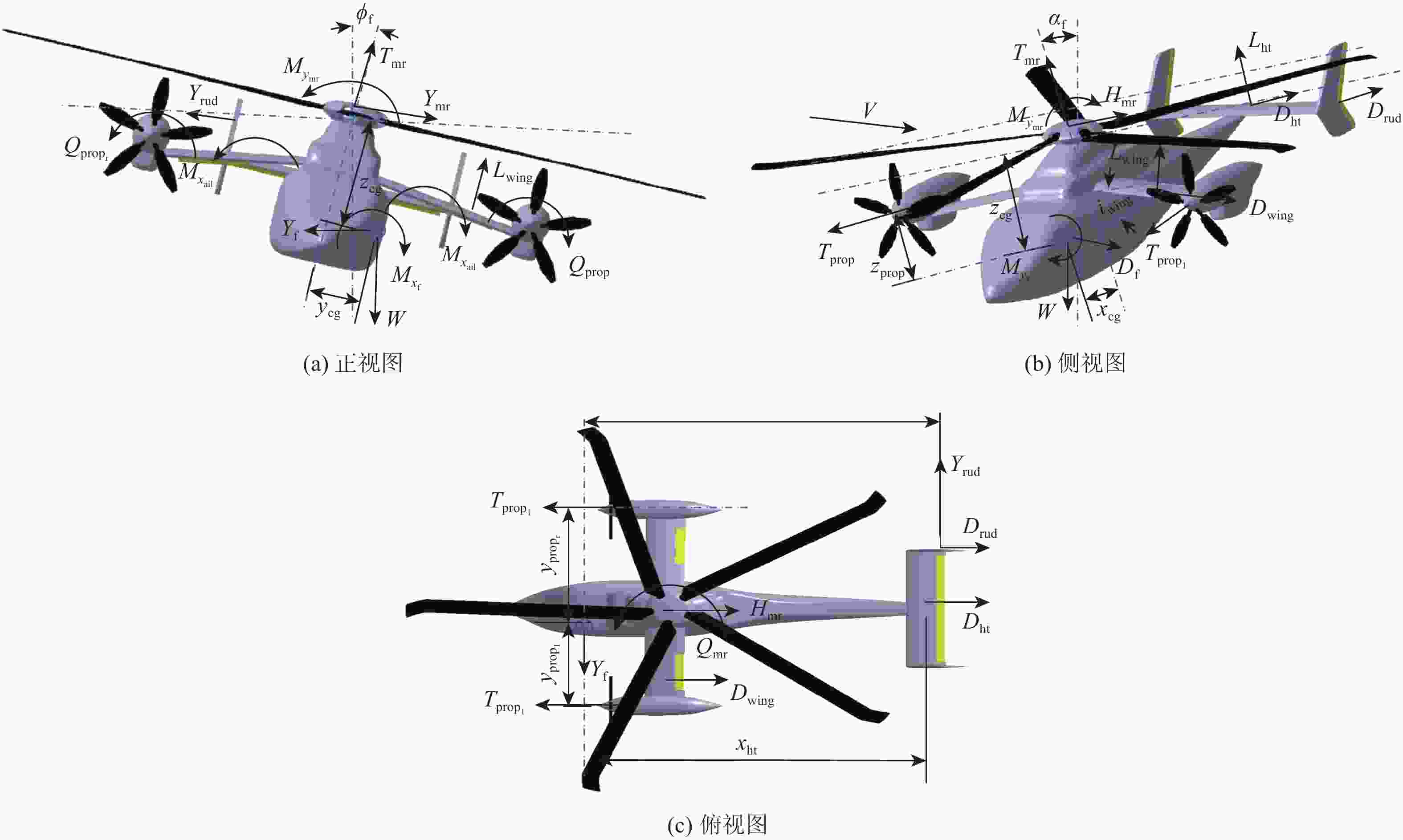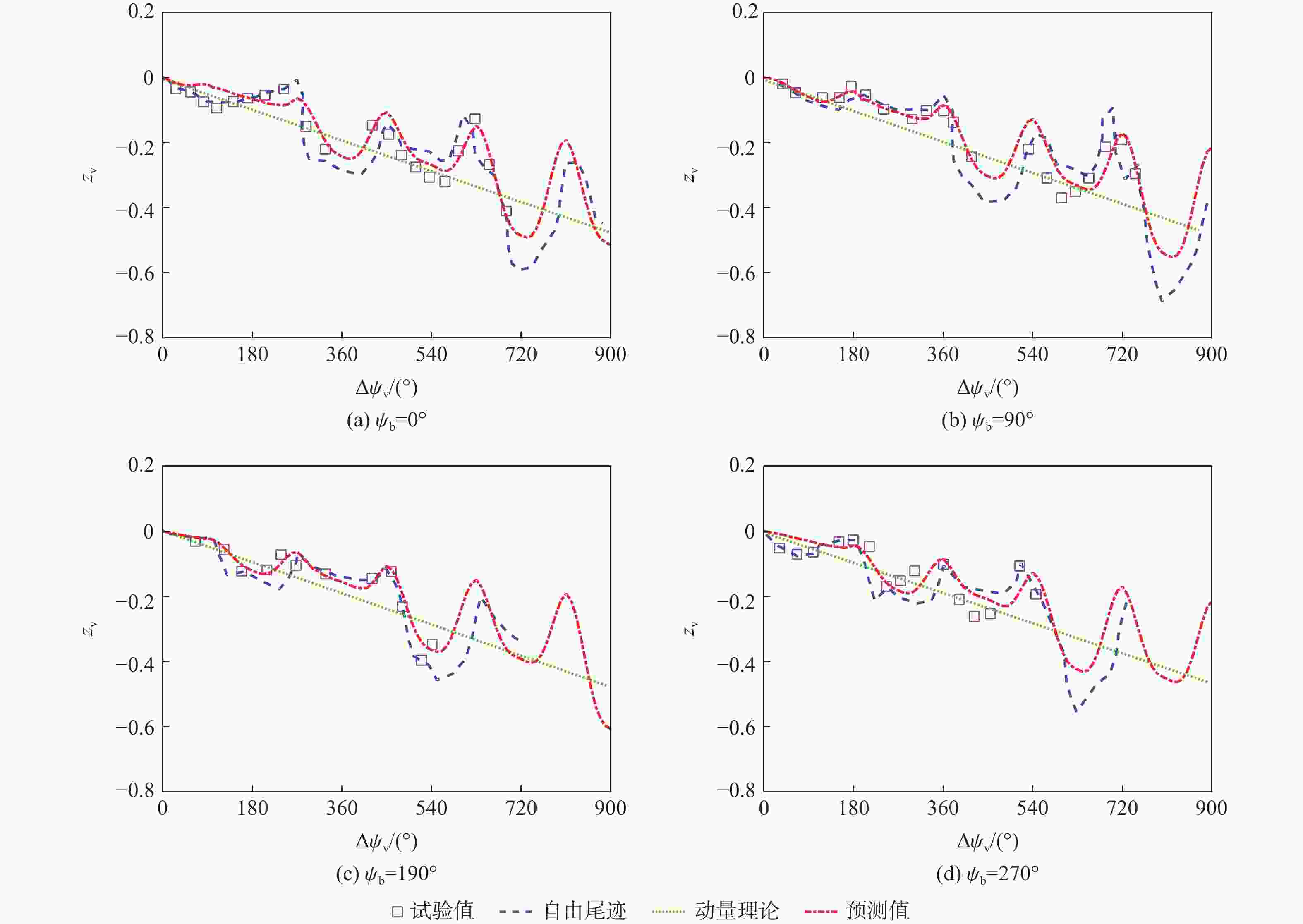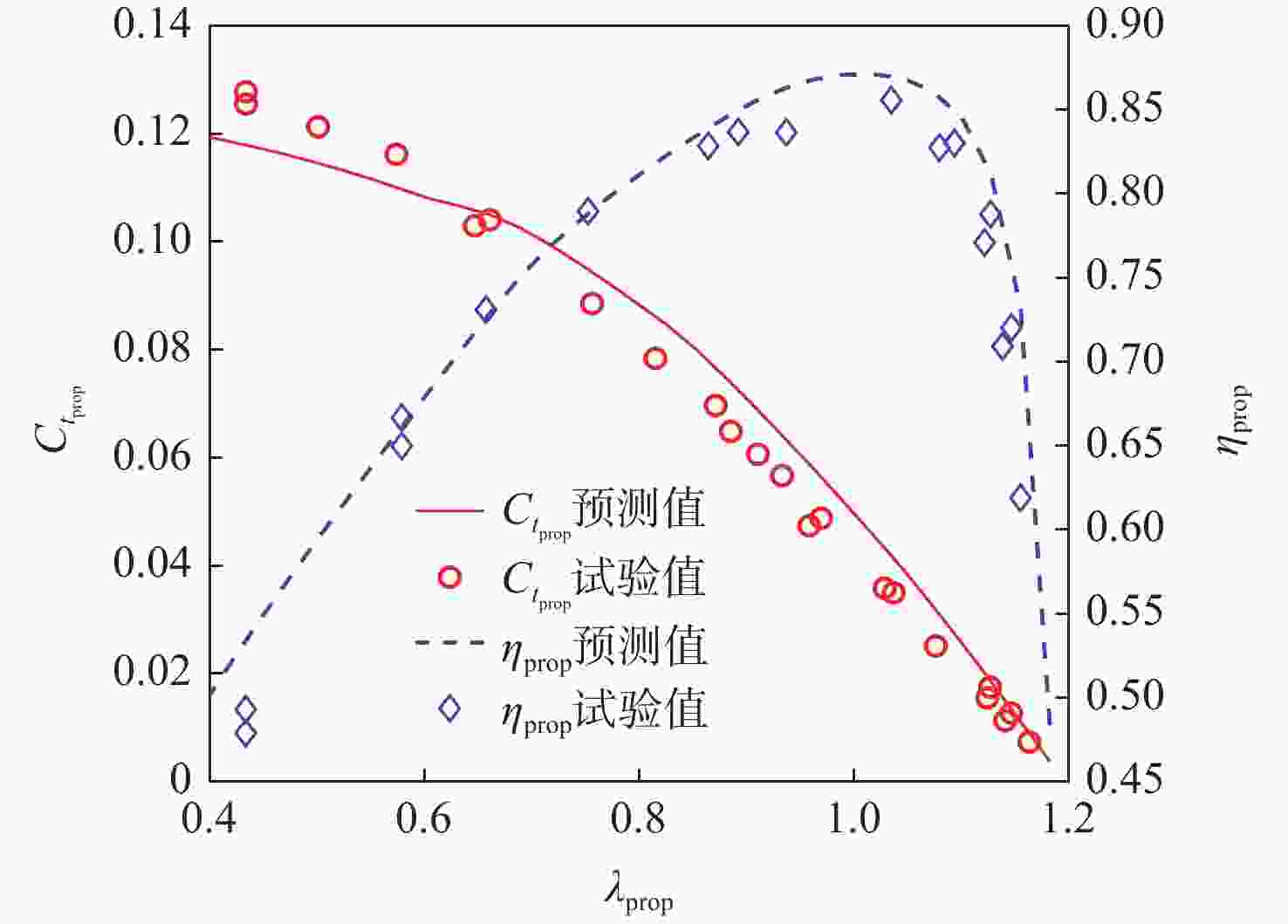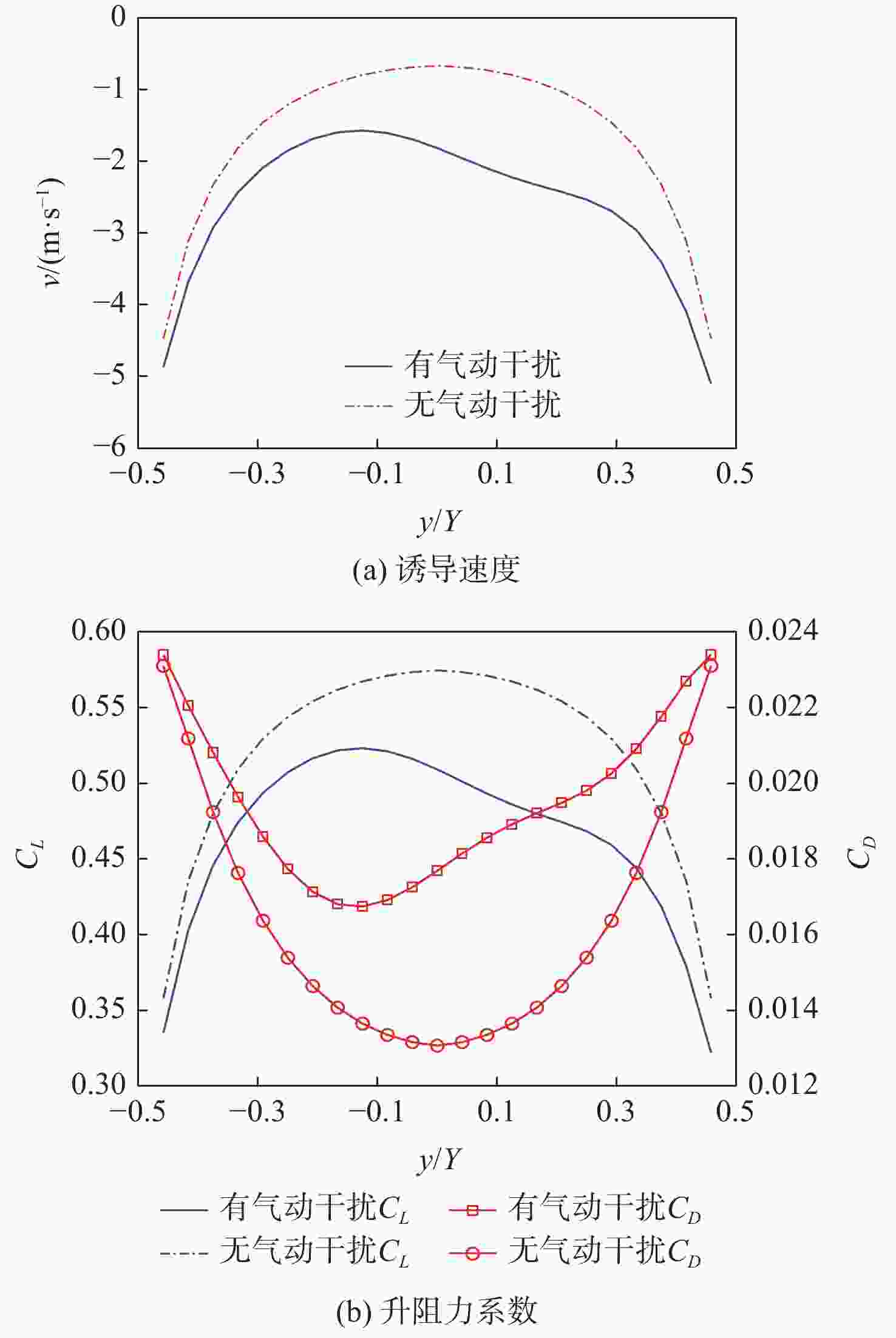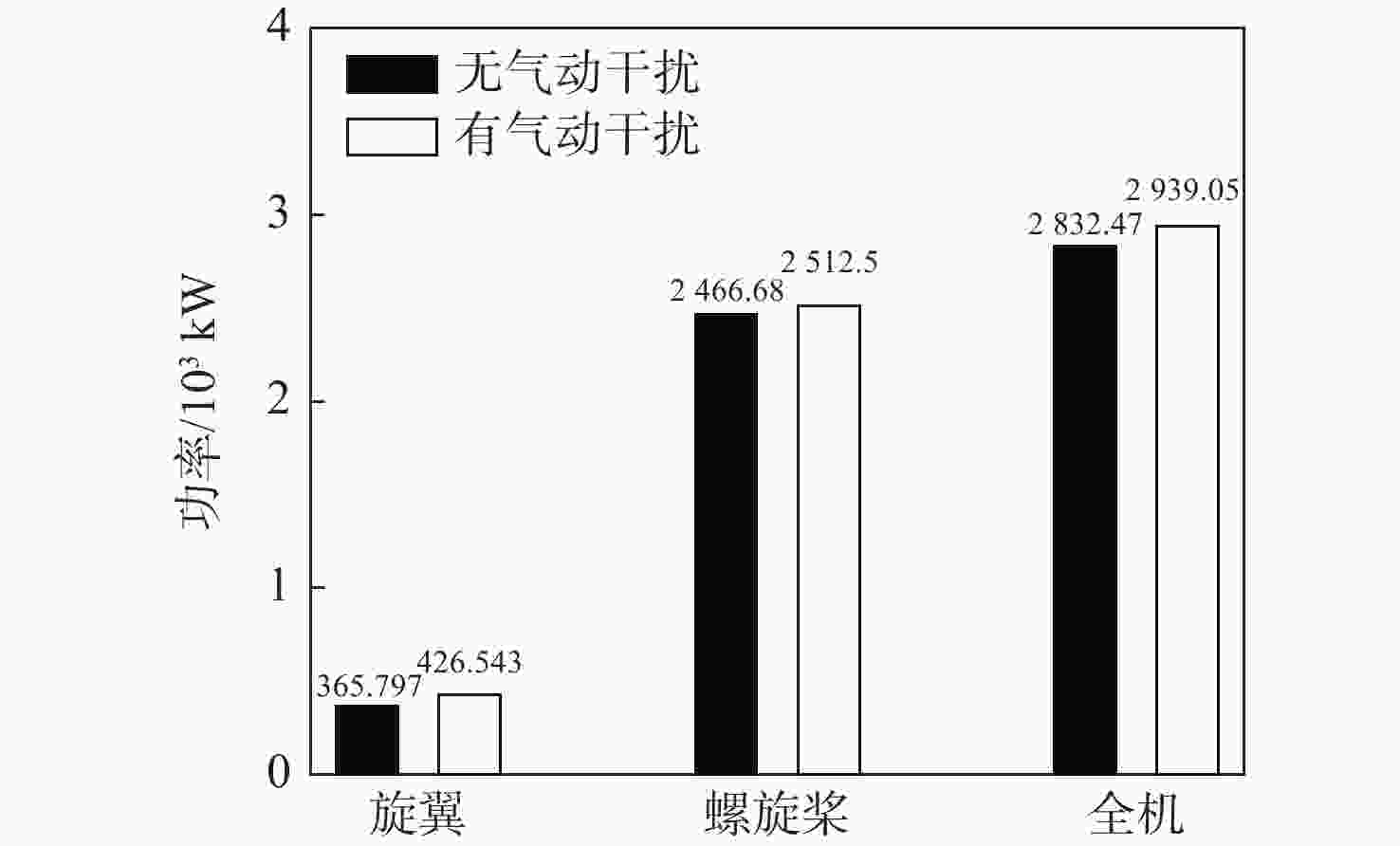Influence of rotor/wing aerodynamic interference on performance of compound helicopters
-
摘要:
为研究旋翼/机翼气动干扰对双螺旋桨推进复合式直升机的高速飞行性能的影响,建立一种可快速预测复合式直升机飞行性能的模型,以加装机翼和螺旋桨的AS365N“海豚”直升机为样例,分析了400 km/h高速飞行时,旋翼/机翼气动干扰对全机飞行性能的影响及机理,并探讨了用副翼操纵配平气动干扰引起的机翼滚转力矩时,全机功率的变化规律。研究表明:气动干扰增加了机翼的诱导速度,导致机翼的升力系数降低、阻力系数增加。在旋翼不对称涡系的作用下,位于旋翼前行侧下机翼的诱导速度和升阻力系数变化比后行侧的更显著。气动干扰导致机翼升力分配从80.00%降低至71.59%,旋翼升力分配从20.04%增加至28.48%。旋翼、螺旋桨和全机功率分别增加了16.60%、1.86%和3.76%。气动干扰使机翼滚转力矩增加、旋翼滚转力矩减小,利于全机配平,但会增加全机功率。用副翼操纵来平衡由气动干扰引起的机翼滚转力矩时,旋翼侧向周期变距和阻力减小,降低了全机功率。
Abstract:To investigate the influence of rotor/wing aerodynamic interference on the high-speed flight performance of a dual-propeller propelled compound helicopter, a flight performance prediction model of compound helicopters is established. Taking the AS365N ‘Dolphin’ helicopter equipped with a wing and propeller as an example, the influence and mechanism of rotor/wing aerodynamic interference on the flight performance are investigated at a high speed of 400 km/h. The change rule of the helicopter power is investigated when the aileron control is utilized to trim the wing rolling moment caused by the aerodynamic interference. The studies indicate that the aerodynamic interference increases the induced velocity of the wing, resulting in a decrease in the lift coefficient and an increase in the drag coefficient of the wing. Due to the asymmetrical vortex of main rotor, the induced velocity, lift and drag coefficients of the wing under the advancing side of the rotor change more significantly than those on the retreating side. Aerodynamic interference decreases the wing lift share from 80.00% to 71.59%, and increases the rotor lift share from 20.04% to 28.48%. The power of the main rotor, propeller and helicopter is increased by 16.60%, 1.86% and 3.76% respectively. Aerodynamic interference increases the wing rolling moment and decreases the main rotor rolling moment, which is conducive to the aircraft trim, but is inconducive for the power reduction of the aircraft. When the aileron is utilized to balance the wing rolling moment caused by the aerodynamic interference, the lateral cyclic pitch and drag of main rotor are reduced, and hence the aircraft power is decreased.
-
Key words:
- compound helicopter /
- aerodynamic interference /
- flight performance /
- power /
- rotor /
- wing
-
表 1 样例复合式直升机参数
Table 1. Parameters of a compound helicopter
部件 半径/展长/m 平均弦长/m 转速/(rad·s−1) 负扭/(°) 安装角/(°) 翼型 桨叶片数/机翼展弦比 旋翼 5.97 0.385 37.7 −10 OA212/209 5 机翼 8.48 1.25 0 4 NACA65-21 6.78 平尾 4.0 0.90 0 NACA65-210 6.78 螺旋桨 1.35 0.25 157.1 −35 −10 Clark Y 5 -
[1] 倪先平. 未来直升机技术发展展望[J]. 航空制造技术, 2008, 51(3): 32-37. doi: 10.3969/j.issn.1671-833X.2008.03.004NI X P. Development prospect of helicopter technology in the future[J]. Aeronautical Manufacturing Technology, 2008, 51(3): 32-37(in Chinese). doi: 10.3969/j.issn.1671-833X.2008.03.004 [2] 吕春雷, 吴希明, 武庆中. 先进直升机发展现状及设计革新[J]. 航空制造技术, 2013, 56(17): 26-29. doi: 10.3969/j.issn.1671-833X.2013.17.001LYU C L, WU X M, WU Q Z. Development status and design innovation of advanced helicopter[J]. Aeronautical Manufacturing Technology, 2013, 56(17): 26-29(in Chinese). doi: 10.3969/j.issn.1671-833X.2013.17.001 [3] 吴希明. 高速直升机发展现状、趋势与对策[J]. 南京航空航天大学学报, 2015, 47(2): 173-179.WU X M. Current status, development trend and countermeasure for high-speed rotorcraft[J]. Journal of Nanjing University of Aeronautics and Astronautics, 2015, 47(2): 173-179(in Chinese). [4] HIRSCHBERG M J. X2, X3, S-97 and X-49: The battle of the compounds is joined[J]. Vertiflite, 2010, 56(4): 16-22. [5] 杨克龙, 韩东, 石启鹏. 升推力装置对复合直升机飞行性能的提升[J]. 航空动力学报, 2020, 35(11): 2429-2439.YANG K L, HAN D, SHI Q P. Lifting and propulsion devices for flight performance improvement of a compound helicopter[J]. Journal of Aerospace Power, 2020, 35(11): 2429-2439(in Chinese). [6] YANG K L, HAN D, SHI Q P. Study on the lift and propulsive force shares to improve the flight performance of a compound helicopter[J]. Chinese Journal of Aeronautics, 2022, 35(1): 365-375. doi: 10.1016/j.cja.2021.02.010 [7] LYNN R R. Wing-rotor interactions[J]. Journal of Aircraft, 1966, 3(4): 326-332. doi: 10.2514/3.43742 [8] MAKINO K, AKASAKA T, HAMAMOTO Y, et al. Experimental investigation of the rotor-wing aerodynamic interaction on a compound helicopter in hover[C]//6th Asian/Australian Rotorcraft Forum & Heli Japan. Kanazawa: Vertical Flight Society, 2017. [9] HAMAMOTO Y, AKASAKA T, TANABE Y. Experimental investigation of the rotor-wing aerodynamic interaction on a compound helicopter in high advance ratio[C]//6th Asian/Australian Rotorcraft Forum & Heli Japan. Kanazawa: Vertical Flight Society, 2017. [10] YEO H. Design and aeromechanics investigation of compound helicopters[J]. Aerospace Science and Technology, 2019, 88: 158-173. doi: 10.1016/j.ast.2019.03.010 [11] ORCHARD M, NEWMAN S. Some design issues for the optimisation of the compound helicopter configuration[C]//56th American Hclicopter Society Annual Forum. Kanazawa: Vertical Flight Society, 2000. [12] SUGAWARA H, TANABE Y. Numerical investigation of rotor/wing aerodynamic interactions at high advance ratios[J]. Journal of Aircraft, 2019, 56(6): 2285-2298. doi: 10.2514/1.C035370 [13] SUGAWARA H, TANABE Y. A study of rotor wing aerodynamic interaction at high speed flight on a compound helicopter[C]//6th Asian/Austrailian Rotorcraft Forum & Heli Japan. Kanazawa: Vertical Flight Society, 2017. [14] FREY F, THIEMEIER J, ÖHRLE C, et al. Aerodynamic interactions on airbus helicopters' compound helicopter RACER in cruise flight[J]. Journal of the American Helicopter Society, 2020, 65(4): 1-14. [15] 万佳, 陈铭. 机翼位置对复合式直升机旋翼-机翼干扰的影响[J]. 北京航空航天大学学报, 2009, 35(5): 519-522.WAN J, CHEN M. Influence of wing location on rotor-wing interaction of compound helicopter[J]. Journal of Beijing University of Aeronautics and Astronautics, 2009, 35(5): 519-522(in Chinese). [16] 万佳, 陈铭. 复合式直升机前飞状态旋翼-机翼干扰计算分析[J]. 航空动力学报, 2009, 24(11): 2459-2464.WAN J, CHEN M. Rotor-wing interaction analysis of a compound helicopter in forward flight[J]. Journal of Aerospace Power, 2009, 24(11): 2459-2464(in Chinese). [17] 赵寅宇, 黎鑫, 史勇杰, 等. 双拉力螺旋桨构型复合式高速直升机旋翼/螺旋桨干扰流场分析[J]. 南京航空航天大学学报, 2017, 49(2): 154-164.ZHAO Y Y, LI X, SHI Y J, et al. Analysis on rotor-propellers interaction flowfield for compound double-thust-propeller high-speed helicopters[J]. Journal of Nanjing University of Aeronautics and Astronautics, 2017, 49(2): 154-164(in Chinese). [18] 申遂愿, 朱清华, 朱振华, 等. 高速直升机旋翼/螺旋桨/机身干扰特性分析[J]. 航空工程进展, 2020, 11(1): 46-55.SHEN S Y, ZHU Q H, ZHU Z H, et al. Analysis of rotor/propeller/fuselage interference characteristics of high-speed helicopter[J]. Advances in Aeronautical Science and Engineering, 2020, 11(1): 46-55(in Chinese). [19] LEISHMAN J G, BI N P. Experimental investigation of rotor/lifting surface interactions[J]. Journal of Aircraft, 1994, 31(4): 846-854(in Chinese). doi: 10.2514/3.46570 [20] 黄明其, 徐栋霞, 何龙, 等. 常规旋翼构型复合式高速直升机发展概况及关键技术[J]. 航空动力学报, 2021, 36(6): 1156-1168.HUANG M Q, XU D X, HE L, et al. Development overview and key technologies of high speed hybrid helicopter with single main rotor[J]. Journal of Aerospace Power, 2021, 36(6): 1156-1168(in Chinese). [21] ORMISTON R A. Revitalising advanced rotorcraft research and the compound helicopter[J]. The Aeronautical Journal, 2016, 120(1223): 83-129. doi: 10.1017/aer.2015.5 [22] 张勇刚, 崔钊, 韩东, 等. 加装格尼襟翼旋翼的直升机飞行性能[J]. 航空学报, 2016, 37(7): 2208-2217.ZHANG Y G, CUI Z, HAN D, et al. Flight performance of helicopter rotors with Gurney flaps[J]. Acta Aeronautica et Astronautica Sinica, 2016, 37(7): 2208-2217(in Chinese). [23] 董晨, 韩东, 杨克龙. 独立桨距控制对直升机飞行性能的影响[J]. 航空学报, 2018, 39(10): 222075.DONG C, HAN D, YANG K L. Effect of individual blade pitch control on flight performance of helicopters[J]. Acta Aeronautica et Astronautica Sinica, 2018, 39(10): 222075(in Chinese). [24] BEDDOES T S. A wake model for high resolution airloads[C]//2nd International Conference on Basic Rotorcraft Research. New York: Vertical Flight Society, 1985. [25] HEYSON H H, KATZOFF S. Induced velocities near a lifting rotor with nonuniform disk loading: NACA-TN-3690[R]. Hampton: Hampton NACA Langley Aerorktical Laboratory, 1957: 26-34. [26] LEISHMAN J G. Principles of helicopter aerodynamics[M]. 2nd ed. Cambridge: Cambridge University Press, 2006: 599-601. [27] BHAGWA M J, LEISHMAN J G. Generalized viscous vortex model for applications[C]//The 58th Annual Forum and Technology Display of the American Helicopter Society. Montreal: Vertical Flight Society, 2002. [28] CUMMINGS R M, MASON W H, MORTON S A, et al. Applied computational aerodynamics: A modern engineering approach[M]. Cambridge: Cambridge University Press, 2015: 60-630. [29] HU H. Study of the trac airfoil table computational system: NASA-CR-1999-209323[R]. Hampton: Hampton NASA Langley Research Center, 1999: 5-15. [30] GUDMUNDSSON S. General aviation aircraft design[M]. 2nd ed. Butterworth-Heinemann: Butterworth-Heinemann Press, 2014: 387-388. [31] MCCORMICK B W. Aerodynamics, aeronautics, and flight mechanics[M]. 2nd ed. New York: John Wiley & Sons, Inc., 1995: 90-100. [32] 刘沛清. 空气螺旋桨理论及其应用[M]. 北京: 北京航空航天大学出版社, 2006: 75-82.LIU P Q. Air propeller theory and its application[M]. Beijing: Beihang University Press, 2006: 75-82 (in Chinese). [33] LANDGREBE A J, BELLINGER E D. An investigation of the quantitative applicability of model helicopter rotor wake patterns obtained from a water tunnel: AD-739946[R]. Hampton: Hampton United Aircraft Corporation Research Laboratories, 1971: 25-36. [34] ELLIOTT J W, ALTHOFF S L, SAILEY R H. Inflow measurements made with a laser velocimeter on a helicopter model in forward flight. Volume 1. Rectangular planform blades at an advance ratio of 0.15: NASA-TM-100541[R]. Hampton: NASA Langley Research Center, 1988: 56-64. [35] SIVELLS J C. Experimental and calculated characteristics of three wings of NACA 64-210 and 65-210 airfoil sections with and without 2 degree washout: NACA-TN-1422[R]. Hampton: NACA Langley Memorial Aeronautical Laboratory, 1947: 68-79. [36] DA ROCHA SANTOS P D. Aero-structural wing analysis using a vortex, lattice method coupled with an equivalent plate model[D]. Beira: Universidade da Beira Interior, 2011: 19-20. [37] THEODORSEN T, STICKLE G W, BREVOORT M J. Characteristics of six propellers including the high-speed range: NACA-TR-594[R]. Hampton: Hampton NACA Langley Memorial Aeronautical Laboratory, 1937: 25-36. [38] SHI Y J, XU G H, WEI P. Rotor wake and flow analysis using a coupled eulerian-lagrangian method[J]. Engineering Applications of Computational Fluid Mechanics, 2016, 10(1): 384-402. doi: 10.1080/19942060.2016.1174887 -







 下载:
下载:



